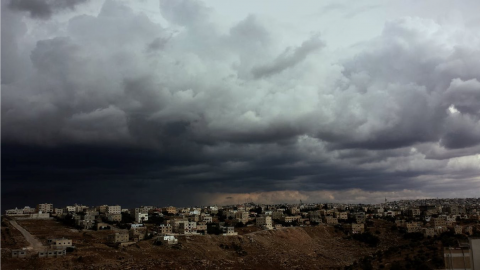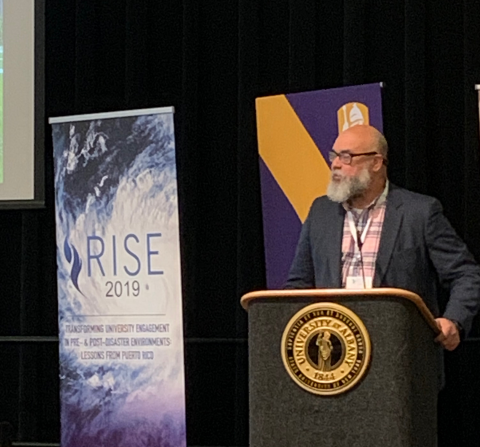In the era of climate change—where the frequency of extreme weather and disaster events is increasing and social inequality magnifies their impact—universities are acting as first responders without being designed or organized to serve in this role. Immediately after major events such as Hurricane Maria’s catastrophic impact on Puerto Rico two years ago, universities have mobilized their communities to send support. Professors, students, and staff organize donation drives for disaster victims, researchers travel to disaster-stricken areas to collect perishable data, and institutions outside the affected areas provide temporary shelter for displaced students to continue their studies while their universities are being rebuilt. However, these efforts are often individual initiatives that risk competing with one another and do not necessarily align with locally concerted recovery and reconstruction efforts. In fact, academics have historically been very good at “observing” reality but not so good at perceiving themselves as “actors” in a disaster landscape.

Universities are important pieces in the puzzle of community resilience. Institutions of higher education are embedded systems inside landscapes of risk. While disasters are becoming the new normal, the business-as-usual of academia will have to change. A few examples include:
-
The lack of coordination among university interventions—and lack of knowledge about the intricacies of local environmental, political, economic, and cultural conditions—can bring the saturation of some areas during research and/or humanitarian aid at the expense of others that are in need.
-
On the one hand, universities that have just suffered the impact of an extreme natural event are the institutional recipients of local contextual and scientific knowledge. On the other hand, they have just experienced disruptions to their own organizational, physical, economic, and political infrastructures and processes. Therefore, they must balance their desire to contribute to science and to the local management efforts with their own response, recovery, and reconstruction processes.
-
Some university interventions transcend the geographical place of the disaster. When universities offer temporary shelter to displaced students and faculty without considering the special needs of that population, the emotional, economic, and social impacts can significantly affect the long-term recovery processes at the individual as well as the community levels.
-
The compounding vulnerabilities of disaster-stricken communities, a highly-traumatized pool of potential participants, put into question the very foundation of the ethics of research with human subjects and the related law-mandated protocols: the absolute respect for the individual’s capacity to give informed consent for participation. When research teams parachute into a disaster area, their presence can be construed as relief work and their questioning as a requisite for disaster aid.
These examples represent not only an ethical and humanitarian problem, but also a scientific one. Lack of coordination among efforts, unequal relationships among peers, and lack of situational awareness produce selective observations, affecting the quality of our data and of disaster science.
The climate change era forces universities to reflect on the very foundations of higher education and the role that universities will play from now on, not only in disaster response and recovery but also in preventing disasters through a more engaged participation in policy and planning. Recent data on post-disaster recovery and reconstruction suggest that ignoring local knowledge prolonged those processes unnecessarily and to the detriment of the most vulnerable (Platt 2017). In that sense, if universities are the repositories of local knowledge, we have a moral obligation to be more entrepreneurial in inserting ourselves in planning and policy processes. The National Council for Science and the Environment (NCSE) has embraced the complex task of promoting intentional thinking about these issues through the support of an initiative that raised precisely from the experience of Puerto Rican academics through Hurricane Maria: the RISE Network. RISE is an interuniversity collaborative network across the nation determined to envision a new paradigm for university interventions in pre- and post-disaster environments and the role of institutions of higher education in enhancing community resilience. The RISE Network can lower the levels of uncertainty around pre- and post-disaster events and contribute to community resilience through the development of a “meso-net” of regional hubs where universities engage in multisectorial collaboratories for knowledge co-production and the operation of fish bowl observatories where a constant flow and acceleration of data, knowledge, technology, and governance innovation can converge.
RISE held its first planning workshop in Puerto Rico June 21–24, 2018, coordinated by the University of Minnesota School of Architecture and hosted by the National Institute for Energy and Island Sustainability of the University of Puerto Rico. The RISE Puerto Rico Workshop brought together over 90 representatives from 26 universities, including from Puerto Rico and the mainland, 14 local and federal governments, community-based organizations, and several private sector participants. The workshop developed work groups on issues such as the relationships between universities and communities, the macropolitical, economic, and cultural context of resilience, the relationship between resilience and the built environment, and students’ experiences in disasters. The intent of this convergence was to 1) articulate our collaborative vision; 2) explore our collaborative capacity; and 3) define critical research questions and project interventions towards resilience.
Now, with the support of NCSE and key university partners, RISE is transcending Puerto Rico’s experience to guide more just and effective interventions across the nation. RISE is becoming a powerful agent of change in developing a new narrative for the Anthropocene. On November 18–20, 2019, more than 100 universities and 50 agencies and organizations converged in Albany, New York, for a national conference titled the RISE Conference 2019: Transforming University Engagement In Pre- and Post-Disaster Environments: Lessons from Puerto Rico.

From disjointed, fragmented competitors in this socially valuable area of research, universities are moving towards more heterarchical, polycentric, and collaborative relationships and platforms. In the era of climate change, universities can no longer afford to be passive observers of these complex landscapes and processes, nor can they be only mere repositories of scientific knowledge. No one discipline, area of expertise, or academic institution can single-handedly encompass the different types of knowledge necessary to confront these extreme operating environments. NCSE is engaging universities in RISE to support further innovation by academic institutions in technology and in the way they produce, integrate, organize, and share knowledge. This profound shift offers the local communities of university campuses opportunities to engage and connect to leverage shared assets ranging from infrastructure and response strategies to translational science in order to improve and inform local resilience planning prior to, during, and after extreme weather events.
References
Platt, S. (2017). Factors Affecting the Speed and Quality of Post-Disaster Recovery and Resilience. Earthquake Engineering and Structural Dynamics in Memory of Ragnar Sigbjörnsson Geotechnical, Geological and Earthquake Engineering, 369–403. doi: 10.1007/978-3-319-62099-2_19